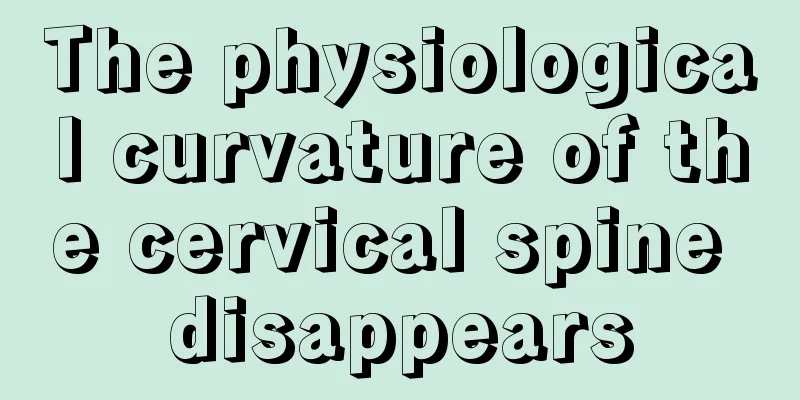The physiological curvature of the cervical spine disappears

|
Generally speaking, under normal circumstances, the cervical spine has a certain curvature and is not straight. The straightening of the physiological curvature of the cervical spine is mostly caused by improper posture. The straightening of the cervical spine is also called the disappearance of the physiological curvature of the cervical spine or the reverse arch of the physiological curvature of the cervical spine. So what are the reasons that lead to the disappearance of the physiological curvature of the cervical spine? What are some good treatment and relief measures? Next I will give you a detailed introduction. Basic Introduction When viewed from the side, the neck of a person sitting or standing appears to be straight. In fact, the cervical vertebrae wrapped inside are not straight, but have an arc that bulges forward in the middle. In medicine, this forward arc-shaped bulge is called the physiological curvature of the cervical spine. Through the cervical spine imaging on the X-ray film: Along this curvature, there is a continuous, smooth arc curve formed at the posterior edge of each cervical vertebra, which is medically called the cervical curvature. Incorrect sitting posture for a long time, long-term fatigue, lack of cervical spine movement, spinal injury, spinal calcification, etc. will cause the physiological curvature of the cervical spine to straighten. Straightening of the physiological curvature of the cervical spine The existence of the physiological curvature of the cervical spine can increase the elasticity of the cervical spine, reduce and buffer the shock of gravity, and prevent damage to the spinal cord and brain. Due to long-term sitting and sleeping postures, and dehydration and degeneration of the intervertebral disc nucleus pulposus, the lordosis of the cervical spine may gradually disappear, and may even become straight or hyperextension curved, that is, convex backwards, becoming one of the more important diagnostic bases for cervical spondylosis on X-rays. Causes (1) Acute cervical muscle sprain: Due to muscle pain and spasm, the muscles pull on the bones, causing the physiological curvature of the neck to become straight. (2) Myofibrosarcoma of the cervical and shoulder regions: Poor sitting posture, catching a cold, etc. may cause myofibrosarcoma of the cervical and shoulder regions, causing the muscles to spasm due to pain. The pain caused by inflammation of the joint capsule, ligaments and small joints can also cause the physiological curvature of the cervical spine to straighten. (3) Radiculopathy: In the acute stage, the affected small joints are acutely inflamed, the joint periosteum and joint capsule are swollen, and the adjacent nerve roots are irritated. Patients often have tension in the neck and shoulders, and their movements are significantly limited, which can cause the physiological curvature of the cervical spine to straighten. (4) Lesions of the cervical spine: Tumors, tuberculosis, and purulent infections of the cervical spine can all cause neck pain, muscle spasms, limited cervical spine movement, and straightening of the physiological curvature. (5) Ankylosing spondylitis can cause cervical stiffness and ankylosing in the late stage. Clinical symptoms The main symptoms are soreness in the head, neck, shoulders, back, arms, stiffness in the neck, and limited movement. Dizziness, spinning head, and vomiting in severe cases are common symptoms. Some people may not experience any symptoms, while others may experience numbness in the hands (radiculopathy of cervical spondylosis), neck pain and discomfort, etc. due to compression of the nerve roots. In more serious cases, they may experience dizziness, blurred vision, nausea, and vertigo when walking. Cervical spondylosis is a disease that seriously endangers the health of desk workers, and its manifestations are varied. The main symptoms include neck and back pain, upper limb weakness, numbness of fingers, dizziness, nausea and even blurred vision and swallowing. Treatment Most patients will experience symptoms such as neck stiffness, limited movement, and local muscle soreness. There are many clinical methods for straightening the physiological curvature of the cervical spine, such as minimally invasive therapy, cervical traction |
<<: The physiological curvature of the cervical spine exists
Recommend
What are the drug treatments for advanced prostate cancer
Prostate cancer is a malignant tumor that occurs ...
Who can't eat apricots
Apricot is a common fruit. Many people like to ea...
How to quickly relieve thigh pain
The symptom of thigh pain is quite common. There ...
Can you eat the green flesh of Hami melon?
I believe that when you buy Hami melons and take ...
Seven steps to prevent occupational cervical spondylosis
Step 1 - Change the pillow Three principles: mode...
What are the hazards of alcoholic fatty liver
Alcoholic fatty liver disease is a particularly h...
Is it easy to get colon cancer after gallbladder removal?
Cholecystectomy will not directly lead to colon c...
The role of calcium supplement
Calcium is very important to us, and the content ...
What happens if you eat hot and cold food alternately
The health of diet has always been a concern of e...
Mouth ulcer and swollen face
Oral ulcers are mainly caused by damage to the mu...
8 types of people are most likely to suffer from bad breath
Who is prone to bad breath? There are many reason...
How often should I have a cystoscopy after bladder cancer surgery?
Cystoscopy is recommended for follow-up after bla...
What are the top ten benefits of hand care?
In life, many men are relatively rough. They don&...
What are the effects of bell peppers
Bell peppers are actually a common guest on the d...
Taboos after getting a lip piercing
There is a saying in the business world that wome...









